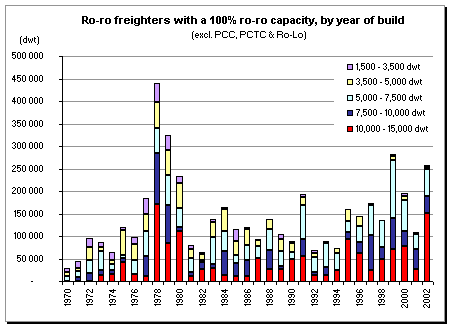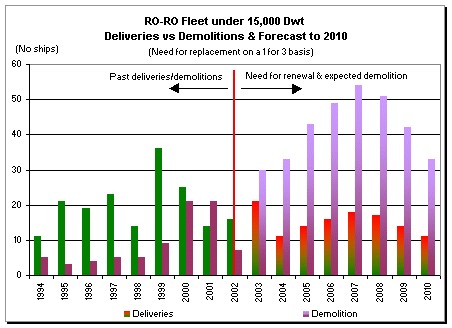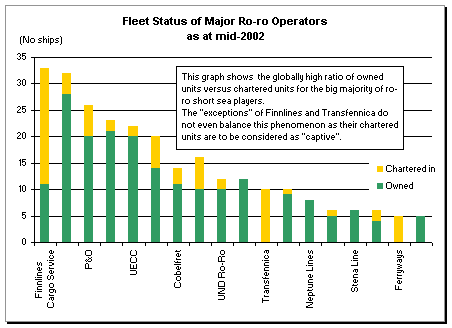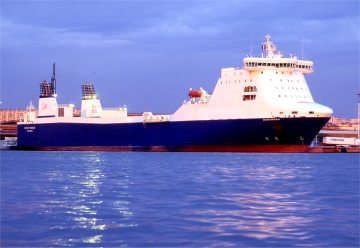
|
The Ro-Ro market in 2002
|
Is the ro-ro concept only dedicated to extremes?
Future race to gigantism?
|
| Is the ro-ro concept only dedicated to
extremes? |
|
|
The niches where the general ro-ro concept is likely
to remain and be developed are definitely short-sea trade routes with an increasing need for fast
tonnage and deep-sea trade with rolling cargoes only. There seems to be very little future for
intermediate distance routes where ro-ro ships actually load combinations of rolling and
containerised cargoes, because of poor financial returns. The interaction between the container and
the 'roll-on / roll-off' concepts on main routes often resulted in ro-ro tonnage being unable to
compete against the operationally cheaper containerships. This trend is unlikely to reverse.
Wilhelmsen's decision to convert their four super carrier designed initially to carry around 2,500
teu into vessels loading only rolling cargo is a strong example of the limits between flexibility
and economy. To make economic sense on long haul routes, vessels have to be specialised, large and
fast like the new generation of PCTC. South America and West Africa are the only significant areas
served by medium-size units plying intermediate distance routes and loading mixed cargoes. We feel
that there is a clear need of rationalisation there, and few of the existing operators have really
yet taken concrete steps towards such a change. The economical crisis in South America in 2002 has
substantially reduced import volumes, and as a consequence could possibly, in the medium term,
further accelerate this rationalisation process on lines serving the southern hemisphere from North
Europe and the Mediterranean.
The ro-ro fleet remains quite old and this appears clearly in the graph page #. In terms of number
of units, tonnage of 25 years old and over represents 17 % of the total ro-ro fleet. The latter
focuses on tonnage of less than 15,000 dwt which, for statistical purposes, we have arbitrarily
taken as a benchmark limit of tonnage deployed on short-sea trade.
|

|
|
Most of the ships that are today 25 years old or
more, will be scrapped in the short / medium term and scrapping activity for large units in
particular has increased in 2002. Based on the existing figures and a reasonable scrapping ratio, we
expect the average age of the fleet to be circa 18 years by 2005, and circa 15 years old by 2010.
Over the past few years, there has been an interesting matching process between tonnage ordered,
tonnage scrapped, and tonnage delivered. Considering the prospects of an unavoidable rise in
scrapping activity, and the limited number of ships ordered since 2001 the market could in theory be
characterized by a shortage of tonnage by 2005. But, bearing in mind that the ro-ro market is a very
small segment, our view is however that there will be no sudden change in the balance of available
tonnage, but rather a tendency for operators to continue ordering ships fitting their needs, further
reducing the volume of the time charter activity.
The graph of forecast for renewal of the fleet has been made observing that:
-
Average capacity of 25 year old tonnage is
about 1,200 lane metres,
-
Average capacity of recently delivered
ships is about 2,500 lane metres,
-
And on assumptions that :
-
Ro-ro units deployed in deep-sea trade are
likely to be replaced by PCTC and containerships. Benchmark size for deep-sea traders was
set here at 15,000 dwt and above, whereby this projection focuses on tonnage of less
than 15,000 dwt.
-
Cargoes carried today by independent
shipowners on the oldest units will be split between containerships and tonnage deployed
by well established short-sea trade operators, once the oldest units are scrapped.
-
Increased speed of new vessels will result
in larger volumes shipped on given routes.
Based on the above and in order to build such a
prediction we have applied a renewal ratio of 3 to 1 between vessels to be scrapped and those to be
delivered for replacement.
|

|
|
When analysing the type of tonnage ordered by tramp
owners and operators in the last 7 years, the clear tendency has been to order larger units (2,400 /
3,000 lane metres), whilst medium-size ships dedicated to the tramp market (1,500 / 2,000 lane
metres) seem to have been somehow 'forgotten'. We feel that the next developments to come will
call for tonnage in the 1,500 / 2,000 lane metres segment, built with rather high specs and
flexibility in terms of cargo configuration (hoistable cardecks, good manoeuvrability) and speed of
20 knots and over.
Once again, the charter market activity has been predominant in North Continent and Mediterranean
Sea areas. An important proportion of the chartered tonnage replaced by own tonnage lead the main
operators to much less activity on the chartering side, whilst a good proportion of available ships
was fixed for military movements, as observed already over the past few years. Governmental
organisations are now more acquainted with the use and benefits of ro-ro tonnage. Most of these old
units released from their time charter commitments were actually sold to either end-users or mainly
Greek tramp owners. Whilst trade in the Baltic Sea sustained good chartering activity at the
beginning of the year, the Spanish and Italian markets could prove to become new grounds for further
developments, with local operators investing in second-hand tonnage. No tramp shipowner dared
however to bet massively on buying second-hand tonnage to play the market on a speculative basis,
and this is certainly a wise decision.
As a consequence of orders placed during the past few years, the average age of tonnage owned by the
main operators has been lowered substantially and the ratio of chartered tonnage in their global
operated fleet has also been reduced. On the other hand, very few tramp owners are able to offer
today modern tonnage for the charter market, but they will definitely be the ones to whom the
operators will go when their development will call for extra capacity. Short-sea trade is in our
opinion the real window for future development and will lead to an upturn of the chartering
activity.
|

|
|
Given the incentive subsidies dedicated to the Marco
Polo programme that the EU is due to support and the increasing demand of tonnage from military
organisations, the market could rebound in the coming year. The age profile of the fleet is also an
element on which we expect a market upturn due to a probable tonnage scarcity during 2003 and 2004
for good quality ships. There are numerous projects to open new services, in particular those to
fight road congestion and the success of new routes will be one of the major catalysts for expansion
of the fleet in the longer run. The longer distance the 'sea highways' will cover, the more
standard unaccompanied trailer ships will be needed.
Out of 25 pure ro-ro ships on order by end 2002 (leaving out PCTC and large ro-pax) only 6 are due
to join the tramp market : three from Stena, two from AWSR and one from Bogazzi (sistership to the
Stena SEC built), all ranging from 2,600 to 3,000 lane metres. This clearly highlights how narrow
the market can be when it comes to availability of modern tonnage for the charter market as seen
from a charterer's point of view. The drawback for tramp shipowners is that they have a very
limited number of serious players in front of them.
The economic downturn affecting the European economies in 2002 inevitably impacted the volumes of
ro-ro cargo, and due to the delivery of new vessels, the charter market has become quite depressed
during the whole year 2002 to the extent that a number of large newly delivered units could hardly
find employment. The balance is however fragile and its sensibility extreme in one direction or the
other. Without any doubt, there will still be a need for ro-ro tonnage in the future and some
segments of the market will need to see rejuvenation of the fleet by means of further orders. In
view of the competitive prices at which tonnage can be built in China in particular, it is quite
likely that this country will provide a good proportion of the ro-ro fleet in the coming years. Some
newly established operators have opted for an interesting alternative, buying good quality ships
likely to have another 5 to 8 years of life. The bet is quite interesting as they will find
themselves in some occasions fighting the majors with ships purchased at low prices and operated at
low costs. In the container sector, Mediterranean Shipping Company has proven that this option can
generate success stories.
|
| Future Race to gigantism? |
|
|
Similarly to the container market, there seems to be
thoughts in the market of building larger and larger units. Projects exist to order trailer carriers
with a capacity in excess of 6,000 lane metres (about 3 times larger than the largest ships deployed
in dedicated trailer trades some 8 years ago). Of course the larger the ships are, the greater the
economies of scale can be achieved. However one should always bear in mind that to make these
economies of scale, vessels have concretely to attract enough cargo to be loaded at a satisfactory
level. Furthermore, on many trade routes, the speed of loading and discharging operations can
significantly affect transit-times that are amongst key performance factors of the ro-ro concept,
and gigantism could eventually be an enemy to these.
Saying this, one should consider these challenges as really serious and not those of dreamers.
Despite intentions to increase vessels' size, the exercise of deploying very large ro-ros on
short-sea trades, will probably be limited due to ports restrictions. However, long term works to
improve port infrastructures and harbours will run in parallel to this trend with a view to match
ship specifications and shore facilities.
|
 |
STENA FORETELLER
ro-ro - 12,300 dwat, 3000 lm, 22 knots.
Delivered from Dalian shipyard in 2002 and chartered to CETAM
|
|
Shipping and Shipbuilding Markets in 2002
I N D E X
|